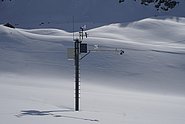Snow height measurements are still the backbone of any snow cover monitoring, whether based on modeling or remote sensing. These ground-based measurements are often realized using ultrasonic or laser technologies. In challenging environments, such as high alpine regions, the quality of sensor measurements deteriorates quickly, especially under extreme weather conditions or ephemeral snow conditions. Moreover, the sensors by their nature measure the height of an underlying object and are therefore prone to returning other information, such as the height of vegetation, in snow-free periods. Quality assessment and real-time classification of automated snow height measurements are therefore desirable for providing high-quality data for research and operational applications. To this end, we propose CleanSnow, a machine learning approach to automated classification of snow height measurements into a snow cover class and a class corresponding to everything else, which takes into account both the temporal context and the dependencies between snow height and other sensor measurements. We created a new dataset of manually annotated snow height measurements, which allowed us to train our models in a supervised manner and quantitatively evaluate our results. Through a series of experiments and ablation studies to evaluate feature importance and compare several different models, we validated our design choices and demonstrated the importance of using temporal information together with information from auxiliary sensors. CleanSnow achieves a high accuracy of almost 98 % and represents a new baseline for further research in the field. The presented approach to snow height classification finds its use in various tasks, ranging from snow modeling to climate science.
See DOISee Institutional Repository DORA

